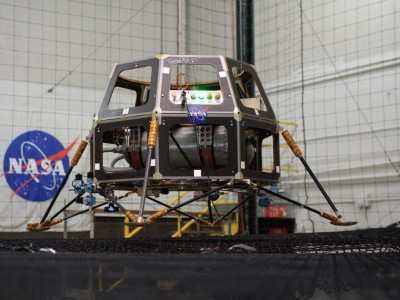Mon, Aug 29, 2011
Mini-Radar System Demonstrated Under Terms Of First Task
Order
Google Lunar X PRIZE contender Moon Express says that it has
successfully demonstrated a critical component of its lunar landing
technology to NASA under its Innovative Lunar Demonstration Data
(ILDD) Program contract. The Moon Express Mini-Radar System
promises to radically reduce the cost and mass of the company's
commercial lunar landing system. The company said Tuesday that NASA
has reviewed and accepted the Moon Express Mini-Radar data package,
satisfying the requirements of the $500K First Task Order under the
company's $10M commercial lunar data contract.
Moon Express Lander

Silicon Valley-based Moon Express was one of only three U.S.
companies awarded the first Task Order under NASA's ILDD program.
Under the task order, NASA agreed to purchase data resulting from
the successful test and demonstration of the company's
state-of-the-art Mini-Radar sensor, a critical component of its
lunar landing system.
Radar provides autonomous landing spacecraft with crucial
ranging information to the surface and has been one of the most
challenging and high risk elements of all lander systems. Radar
systems have also been historically very expensive in terms of
dollars, mass and energy. As part of its risk reduction engineering
activities, Moon Express initiated a program to continue the
development, test and space qualification of an innovative, low
cost, low mass, low energy radar concept invented by Stellar
Exploration that showed great promise through progressive
developments under NASA Small Business Innovation and Research
(SBIR) programs. The Moon Express investment significantly advanced
the radar technology toward spaceflight readiness.
The testing and space validation of the Mini-Radar involved
multiple units subjected to a series of laboratory and field
testing. These included multiple dynamic tests on the Lunar Lander
Test Vehicle, developed in partnership with NASA, and long range
tests on the Zeppelin 'Eureka', owned and operated by Airship
Ventures, which took the Mini-Radar on flight tests down the
California coast and at the Oshkosh Airshow. Additional
environmental testing in thermal-vacuum and vibration chambers
proved the ruggedness of the Mini-Radar design for spaceflight.
More News
Ground Stop (GS) The GS is a process that requires aircraft that meet a specific criteria to remain on the ground. The criteria may be airport specific, airspace specific, or equip>[...]
Aero Linx: Australian Transport Safety Bureau (ATSB) The Australian Transport Safety Bureau (ATSB) improves safety and public confidence in aviation, marine and rail transport thro>[...]
“The Palo Alto stopover confirmed—yet again—that flight schools and aero-clubs are no longer just curious about electric training; they are ready to buy. In just >[...]
Pilot’s Failure To Maintain Clearance From The Water While Flying At A Low Altitude Analysis: The flight of two airplanes was in cruise flight on a north heading about 50 ft >[...]
Also: 48th Annual Air Race Classic, Hot Air Balloon Fire, FAA v Banning 100LL, Complete Remote Pilot The news Piper PA-18 Super Cub owners have been waiting for has finally arrived>[...]
 ANN's Daily Aero-Term (06.30.25): Ground Stop (GS)
ANN's Daily Aero-Term (06.30.25): Ground Stop (GS) ANN's Daily Aero-Linx (06.30.25)
ANN's Daily Aero-Linx (06.30.25) Aero-News: Quote of the Day (06.30.25)
Aero-News: Quote of the Day (06.30.25) NTSB Final Report: ICON A5
NTSB Final Report: ICON A5 Airborne Affordable Flyers 06.26.25: PA18 Upgrades, Delta Force, Rhinebeck
Airborne Affordable Flyers 06.26.25: PA18 Upgrades, Delta Force, Rhinebeck



